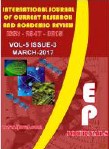Abstract Volume:5 Issue-3 Year-2017 Original Research Articles
 |
Online ISSN : 2347 - 3215 Issues : 12 per year Publisher : Excellent Publishers Email : editorijcret@gmail.com |
2Senior Research Assistant (S.R.A, C.S.T. U.P. Project) Civil Engineering Section, Faculty of Engineering & Technology, Aligarh Muslim University, Aligarh, India
Heavy metals are nonbiodegradable and exist in the environment create a threat to the organism due to their toxic nature removal and recovery of heavy metals from contaminated water is necessary with respect to environmental health and economical considerations. Heavy metals released in waste water from urban and industrial effluents, leakage of sewage pipes, and plumbing fixtures. For this several treatment technologies including adsorption, coagulation, flocculation, precipitation, reverse osmosis, biological process, ionizing, are being used. But many of these technologies are costly when they are used for treating large amounts of water from all of them the adsorption techniques are preferred because of their low cost, high efficiency, ease of operation. Fly ash a waste substance from thermal power plants is found in abundance utilization of fly ash as an adsorbent for the removal of heavy metals it helped reduce the environmental toxic metal burden and increased economic benefit. For this study, various factors affecting the removal of heavy metal ions, such as contact time with the solution, initial pH and adsorbent dose were investigated. The metal ion removal capacities of fly ash increased with increasing pH and a pH value was found to be the optimal pH for maximum metal removal capacity.
How to cite this article:
Haaris Ahsan Safdari, Mohd Kaifiyan. 2017. Biosorption of Lead (II) and Nickel (II) from Dilute Aqueous Solution Using Flyash as a Biosorbent.Int.J.Curr.Res.Aca.Rev. 5(3): 65-70doi: https://doi.org/10.20546/ijcrar.2017.503.010



Quick Navigation
- Print Article
- Full Text PDF
- How to Cite this Article
- on Google
- on Google Scholor
- Citation Alert By Google Scholar
